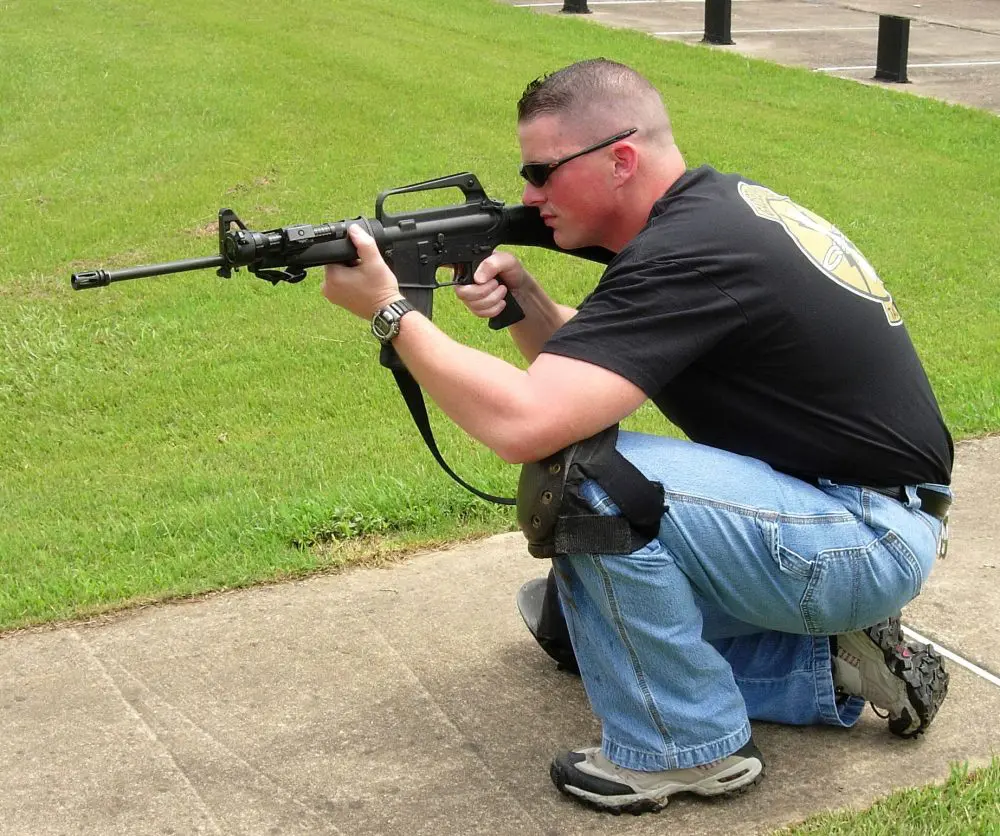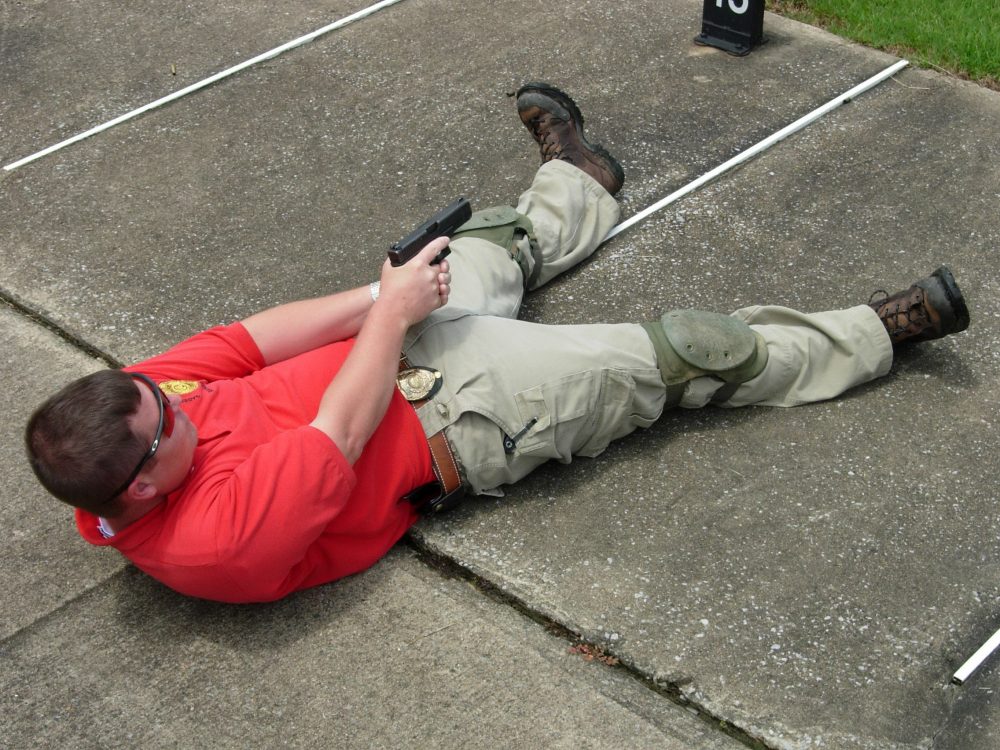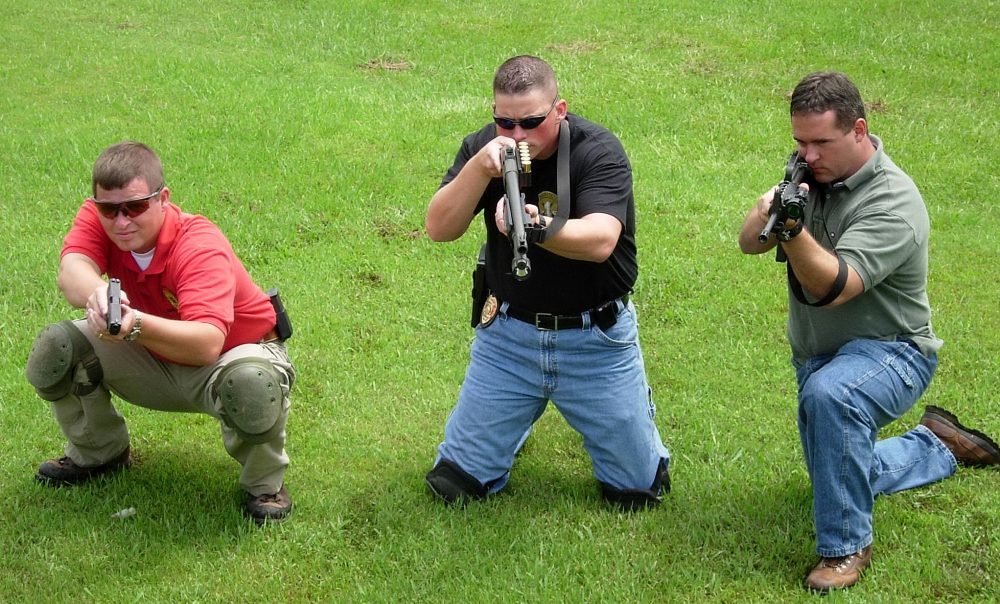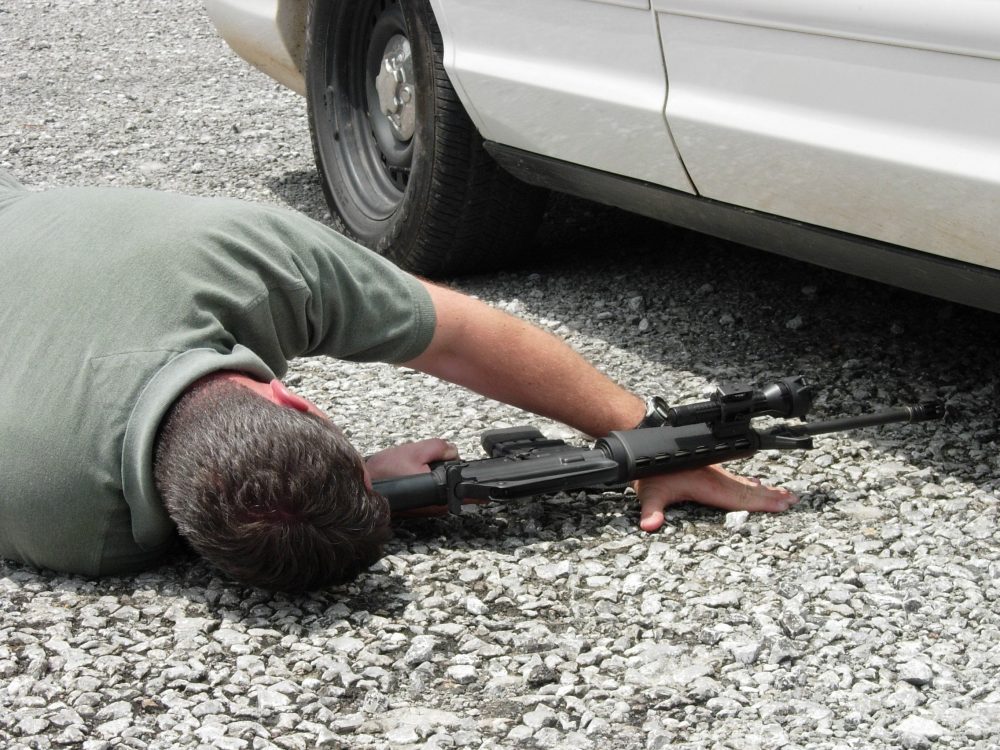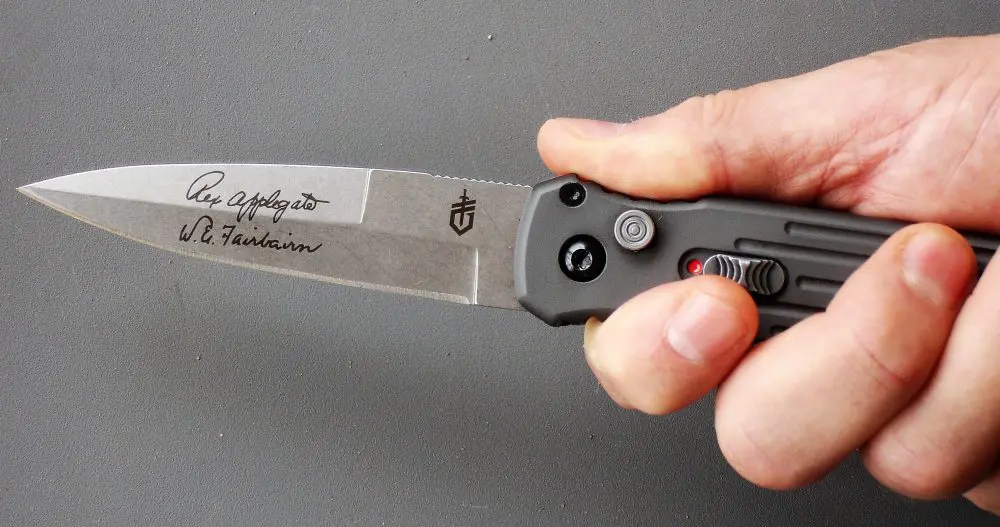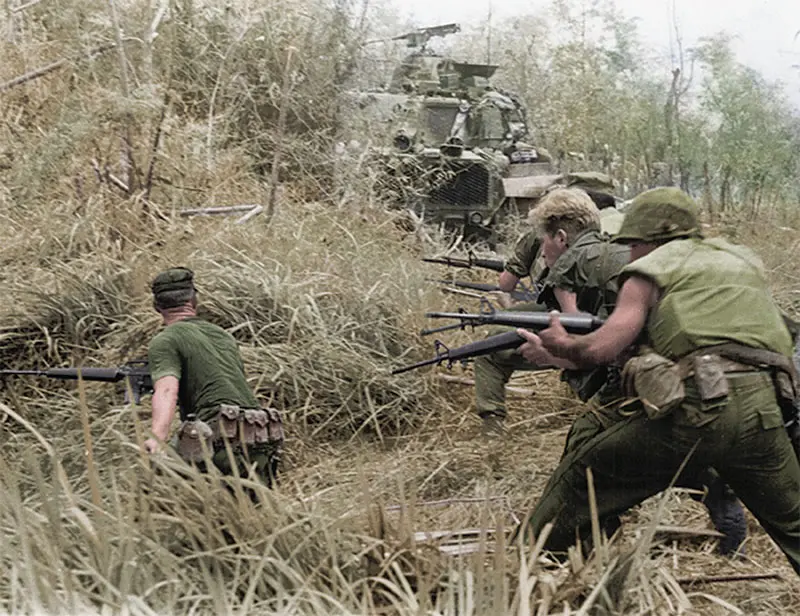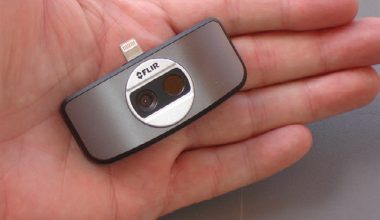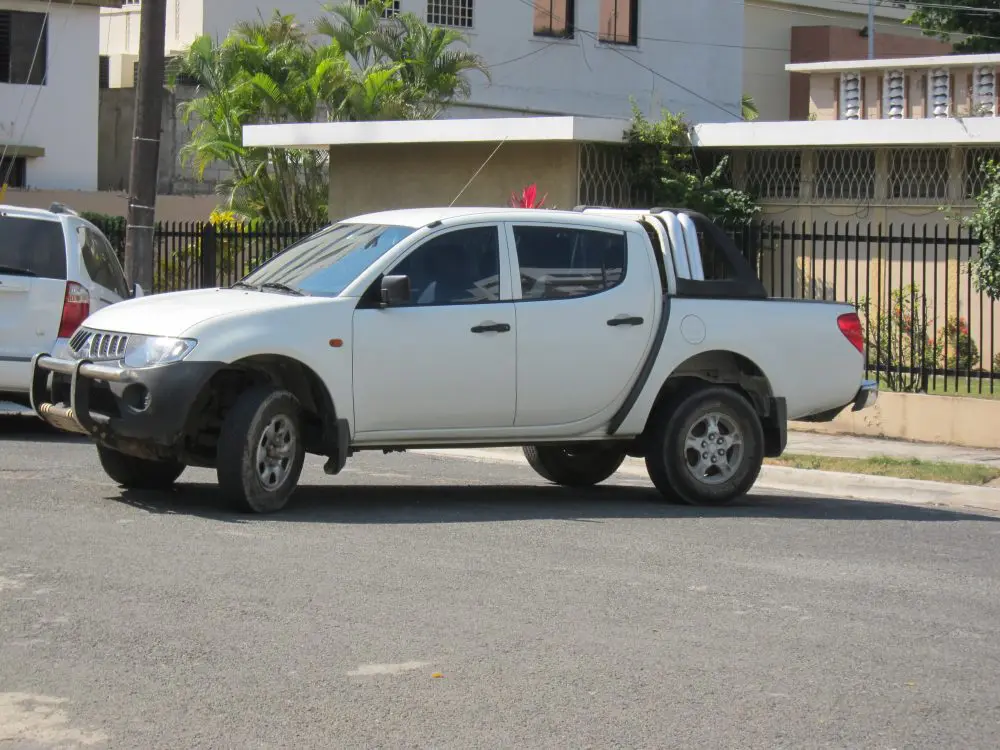The patrol car races down the street towards the two stalled vehicles. The three SWAT officers, responding to the North Hollywood bank robbery, are several blocks from the bank and believe they are approaching an injured citizen. In reality they are heading directly at one of the threats, Emil Matasarenu, who is armed with a full-auto rifle. After using his car to slip through the perimeter of officers surrounding the bank, Matasarenu is now attempting to hijack another vehicle. As their black-and-white unit rocks to a stop, the officers realize their mistake and open fire on the suspect while still inside their vehicle. Matasarenu responds by unleashing a burst of automatic fire. Smoke and glass fragments fill the air as the officers scramble out of their car. Spreading out, they attempt to engage Matasarenu, but between his incoming fire and the obstacles created by the three vehicles the officers are unable to get a clear angle of fire. After repositioning themselves several times without success they drop to the ground, engaging Matasarenu by firing underneath the vehicles.
Braced kneeling, where the support elbow is braced on the support knee, is a premeditated position used when precision shooting is required. Checking and confirming your natural point of aim during practice achieves stability and accuracy. Due to wearing kneepads, this shooter cannot achieve a proper bone-to-bone contact.
After thirty-four minutes and an exchange of nearly 2,000 shots the North Hollywood gunfight is finally over.
Given a choice, your best option in a fight may be to stay on your feet, maintain a mobile fighting platform and move as necessary. Yet, as the North Hollywood firefight illustrates, there are times when standing upright and fighting isn’t going to get the job done. Whether the circumstances involve hunting or defending your life, when you must take cover, change your angle of fire or improve your accuracy, you seldom will be able to employ a textbook shooting position. Friend and former Albuquerque police officer Steve Rodriguez was involved in five shootings during his career and each engagement required a modified position. There is a world of difference between shooting and fighting.
It isn’t unusual during a fight to end up on the ground.
For combative use and teaching purposes, I separate fighting positions into two categories—reactive and premeditated. When the threats are within close range and time is short, reactive positions are employed. Most self-defense and law enforcement engagements fall into this category. So do military operations in urban environments, which normally occur at thirty-five yards and closer. In other words, the bad guys are as close as your neighbors across the street. At these ranges fights tend to be very dynamic with everyone moving. Reactive positions allow you to quickly drop down and get hits on the target in the shortest amount of time possible.
The different variations of kneeling are good examples of reactive positions. Speed kneeling (simply dropping down onto the primary side knee), the double or “California kneeling” (planting both knees on the ground), and the squat aka “rice paddy prone,” are all positions we can assume without a lot of thought or time. Lowering your profile is often necessary to take advantage of cover or concealment, especially in urban environments. The double kneeling position is one of my favorites for working around the side of cover since it allows you to lean out fairly far to either the left or right side, minimizing your exposure to the threat.
Reactive positions such as the squat, double kneel, and un-braced kneeling are quick to assume and, equally important, quick to get out of and back onto your feet.
Reactive positions are also used when you need to change your angle of fire. In close quarters, with the threat surrounded by non-hostiles, it may be necessary to drop down to get a clear angle of fire or to guard against over penetration of your round. The speed kneel is ideal for such situations.
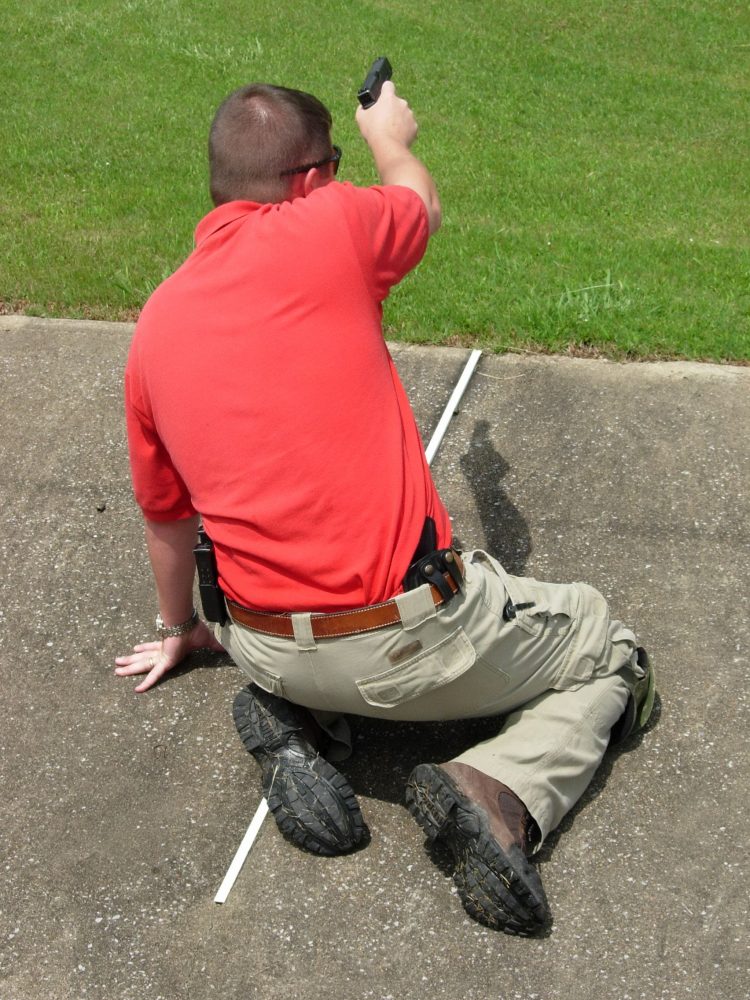
Equally important is how quickly you can recover from reactive positions, getting to your feet and reacting to the fight as it unfolds. In Secret Commandos, an account of SOG operations during the Vietnam war, John Plaster states that reactive positions “made it physically—and especially, psychologically—easier to get up and go when it was time to move through fire… Such little things would keep my men alive.”
When surgical accuracy is required and/or when time permits, premeditated positions can be used in confrontations. These positions require more deliberate thought and action to execute and recover from than reactive positions, but they create extremely stable firing platforms. Lowering the body’s center of gravity and/or creating more contact points between our body and the ground increases stability. Reactive positions lower your center of gravity and are more stable than a standing position. However, for surgical shooting, premeditated positions such as braced kneeling and prone are best.
Braced kneeling begins by assuming the speed kneel, dropping down onto the primary side knee, then you continue to lower your body until the support elbow (left elbow for a right-handed shooter) is braced on the support knee with your rear-end resting on the primary foot. This is an extremely stable position and takes just a little longer than the speed kneel, and when necessary can be maintained for extended periods of time. One disadvantage of braced kneeling is that you can’t lean out very far to the right or left, making it difficult to work around the side of cover without exposing a lot of your body to the threat. Prone is the most stable of premeditated positions and allows extremely precise shots. The problem is that normally it’s too low. Drop down into prone in the woods or an urban environment and you’ll quickly discover a limited field of view due to scrub, brush or the countless obstructions found in both rural and urban settings. However, there are situations where prone is the best choice—usually in a modified configuration.
For example, rollover prone is a modified prone position used to shoot underneath low objects. The shooter rolls onto the primary shoulder and folds the primary arm up underneath the body. When I ask him about it, Clint Smith replies with his usual modesty. “I would not say I came up with it,” but he also admits not “remembering being taught it by anyone. … I started doing it to compensate for scope offsets and in my eye it was an adaptation of (Ray) Chapman’s rollover prone for the handgun…With the rifle it was more about lowering the upper body, shoulders and head.” Rollover prone significantly reduces the height of your firing platform allowing you to shoot underneath objects such as a car.
The rollover prone position lowers your profile and allows you to shoot underneath an object such as a car.
These modified positions, according to Jeff Cooper in The Art Of The Rifle, were called “jackass” positions by the old military. Although improvised positions see frequent use, they are usually reserved for specific conditions.
The reverse kneeling, used to improve accuracy when you have an object to rest or support the front of the weapon against, is a good example of a special purpose position. In a traditional kneel the primary knee is on the ground; however, in reverse kneel the support knee (left knee for a right-handed shooter) is placed on the ground. The support hand braces the front of the weapon against a solid object and the primary elbow rests on the primary knee for support. With both the front of the weapon and the primary elbow supported, the weapon is locked into an extremely stable platform.
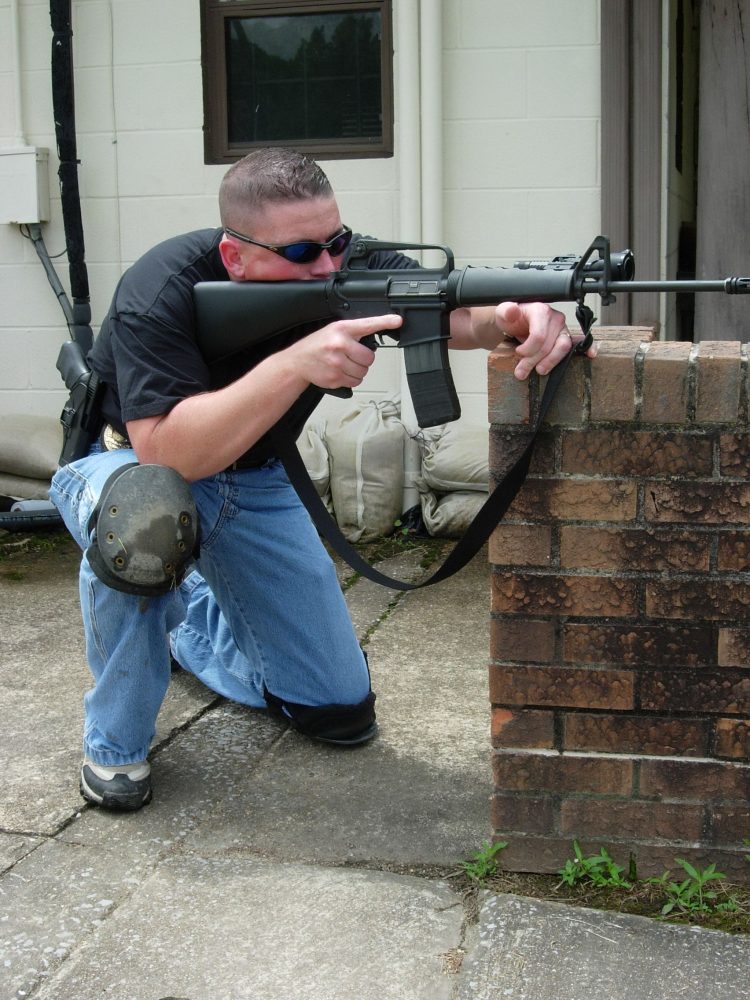
Then there are times when you wind up in a bad position. What most people forget is that fights rarely go as planned. Think back to the fights you’ve been in and count how many times you ended up flat on the ground—and just because you’re armed with a firearm don’t think it still doesn’t happen. David Klinger’s book Into The Kill Zone, a study of violent law enforcement encounters, is full of examples where officers wind up fighting from the ground. Obviously the less time spent on the ground during a fight the better. Your response when this does happen? Get on your feet. Create distance. Engage the threat with accurate fire as often as necessary. Although this sounds simple, it’s not something you want to try learning during a fight.
To become proficient at fighting under all conditions you have to start with the basics. Colonel Charlie Beckwith, the founder of Delta Force, said, “You can’t be unconventional until you’re conventional first.” Apply this principle to your firearms training. Even though it might seem boring, you must begin with traditional shooting positions. Do them slowly and by the numbers. Every time you drop into a position you should check your form and location in relationship to the target. Establishing your natural point of aim, which relies on bone structure as opposed to muscles, will improve accuracy by creating a consistent platform. After doing this enough, you’ll automatically drop into position and have a good sight picture on target. Once you have mastered the fundamentals you are ready to move on to more complicated positions. Do not train to be fast! If you train for speed you will never learn the proper techniques. Allow your speed to increase naturally as a result of repetition.
During training you’ll likely discover some positions that won’t work for you. For example, squatting is one position that only works for about half the people. Depending on flexibility, body type and how many injuries you acquired from jumping out of perfectly good airplanes, there may be some positions you simply cannot do. Keep in mind that training not only includes learning new techniques, but also discovering your personal limitations and how to compensate for them. Toppling out from behind cover because you tried the squat position for the first time during a fight and lost your balance is not cool.
Obviously there are numerous positions that are not discussed in this article. Your task is to experiment with everything you can, choose the ones you’re willing to use in combat and then practice them until proficient. Also keep in mind that these same positions, modified as necessary, will work with rifle, shotgun and pistol.
No matter what position is being used you have to use the sights and trigger properly to make good hits. You can fly around the room like a gravity-defying Kung Fu master, but if you don’t make good hits you won’t win the fight. At the same time you may be the best shot in the world, but if you can’t maintain a stable and balanced position you won’t hit anything.
We’ve all seen guys who can plop down and shoot a tight group, seemingly without effort. There is no magic to it. They’ve developed that ability with dedicated time spent training. And what could be more fun than spending a few extra hours at the range?
[Tiger McKee is Director of Shootrite Firearms Academy]
